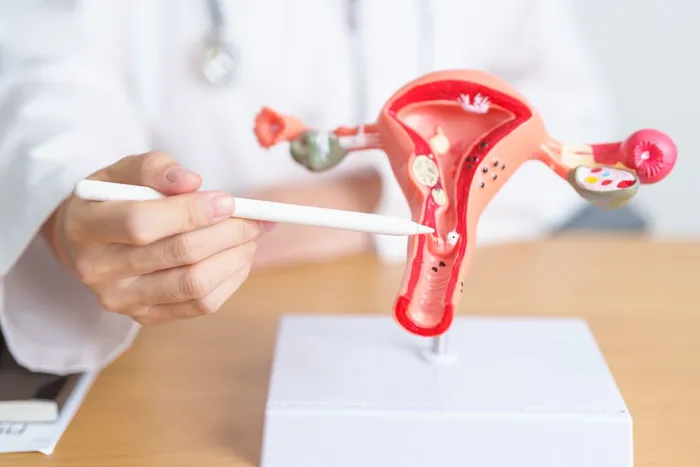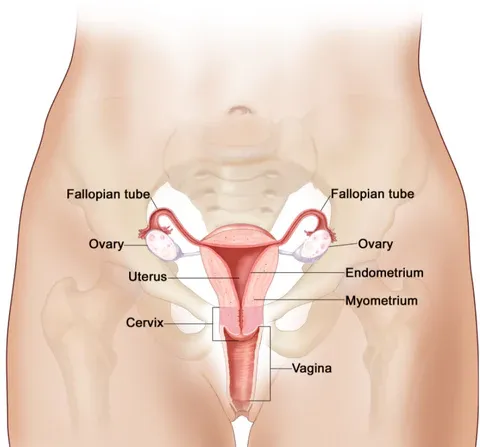How To Check Your Cervix & Why You Should
Updated March 12, 2025.

What Is The Cervix?
The cervix is the bottom third of the uterus. It is the opening between the uterus and vagina. The cervix is an opening of the uterus into the vaginal canal (cervical os), through which babies are born and menstruation leaves.
Is My Cervix Important If I'm Not Pregnant?
One of the biggest misconceptions is that the cervix is only relevant to pregnant women or to birthing couples. Those of you practicing fertility awareness likely already know that the cervix can show us what is happening on a hormonal level within our ovulation cycles.
This information can be used to identify the fertile window so that you can get pregnant or avoid pregnancy (depending on your intention).
When Should I Check My Cervix?
You may wish to check your cervix daily or just at a few important times during your cycle. If you’re new to charting or new to cervix checking, you may want to try daily for one cycle to get the hang of it. (It is not recommended to check your cervix during or right after arousal. All of the arousal tissue will cause the cervix to rise.)
Cervix checks can also be helpful for people during ambiguous phases of fertility, like breastfeeding, just coming off of hormonal birth control, or dealing with very irregular cycles.
And, some folks just try it once as a self-exploration practice.
An example of fertility awareness methods that use cervix checks include:
- TCOYF (Taking Charge of Your Fertility) method
- SymptoPro method
- Boston Cross Check method
- Sensiplan method
How Do I Find My Cervix To Check It? What Will It Feel Like?
Before you try to reach your cervix, you might want to consider what might come up emotionally. This is a part of our bodies that is rarely touched. When it is touched, it’s often not touched lovingly but in a clinical setting. Some of us may hold medical or sexual trauma there.
Remember to be gentle, relaxed, and curious. Find an opportunity when you will have quiet, time, and privacy. When you feel ready, start with clean hands. Many people prefer to check in the shower or on the toilet. You may choose to squat down or prop one leg up (similarly to how you might insert a tampon or menstrual cup). There is really no wrong way, but it may help to choose a position that helps bring the cervix down in the body.
Using one of your longer fingers, reach inside of the vaginal canal as far as you can comfortably go. Most people will find at the tip of their finger what feels like a bump of tissue protruding into the vagina. It may not be exactly where you expect it. Gently explore around the “top” and sides of the vaginal canal until you find some firmer tissue (it will feel like puckered lips or the cartilage of the nose).
If you still can’t reach it, try clenching the pelvic muscles (like bearing down). This will push the cervix lower. Some people are more successful when they put a light amount of pressure just above the pubic bone.
How Does The Cervix Show Us Signs Of Fertility?
The cervix changes depending on the dominance of either estrogen or progesterone. This helps us read our fertility in two ways:
- Through palpable cervix changes
- Through cervical fluid
Cervical fluid (also called cervical mucus, CM, or CF) is a viscous fluid made in the tiny crypts of the cervix. This fluid may be either absent, sticky, or stiff when progesterone is high, or it may be fluid, slippery, or watery when estrogen is high. Of course, this is just a cursory glance at cervical fluid. There are many more resources available if you wish to find out more.
Changes in the cervix can also be felt with fingers. The acronym SHOW outlines a few things to pay attention to.
SOFTNESS: When checking the cervix, it may feel soft, like the tissue of a lip when estrogen is high OR the cervix may feel more firm like the cartilage of a nose or the firm part of the chin when progesterone is high.
HEIGHT: When you reach your cervix, it may feel higher (further away from the opening of the vagina) during the higher estrogen days of your cycle OR the cervix may feel lower (easier to reach or closer to the opening of the vagina) during high progesterone days of the cycle when fertility is low.
Cervical height often changes after a vaginal birth as well. Most people report a lower cervix after giving birth.
OPENNESS: The cervical os may feel more open when estrogen is high OR more closed when progesterone is high. Because everyone’s anatomy is unique, the os may feel more like a dip or like a slit.
The cervical os may also change after a vaginal birth.
WETNESS: This last part refers to cervical mucus (or fluid). You may notice more fertile-quality cervical mucus at the cervix rather than at the vulva. It’s helpful to note, but please refer to the guidelines for your fertility awareness method before charting what you see.
You may notice that your cervix changes in all the ways we’ve listed or that it changes in only one of the ways. This can happen because your uterus is held in place by ligaments. Sometimes the position of the uterus can change. It’s usually not problematic (but if you have painful periods or have been unable to conceive, it might be something to look into).
You may even notice a change that is not mentioned in this article. For instance, you might notice your cervix is usually tilted to the right, but during high fertility it seems to stand up straight - this is totally normal.
Everyone’s anatomy is unique, so these guidelines are just that - guidelines. What is most important is observing regularly and noticing changes. At the end of your cycle, see if you notice a pattern. Most people do.
Looking for more support?
If you’re interested in learning more, you can contact a fertility awareness instructor. Ask the instructor if they offer guidance or support for cervix checks. You can also learn more at beautifulcervix.com. There, you can order a self-exploration kit with a speculum, mirror, and light. Most healthcare providers will also help you get a look with a mirror or even take a picture for you. Getting to know your body in this new way can be a rewarding experience.








